History of Régua, Portugal: A Detailed History and the Top 25 Local Attractions
History of Régua, Portugal
Nestled along the Douro River in northern Portugal, Peso da Régua—commonly referred to as Régua—is a town intrinsically tied to the legacy of the country’s most iconic export: Port wine. The area’s history reaches back to Roman times, with archaeological remains indicating ancient settlements that benefited from the fertile riverbanks and the strategic location along trade routes.

However, it was during the 18th century that Régua came into prominence. In 1756, under the directive of the Marquis of Pombal, the region became the official demarcated area for the production of Port wine, making it one of the world’s first legally defined wine regions. The establishment of the Companhia Geral da Agricultura das Vinhas do Alto Douro was a turning point that transformed Régua into the administrative and logistical heart of the Douro Valley’s wine industry. Grapes harvested from terraced vineyards across the valley were processed and transported from Régua to the city of Porto, where the wine was aged and exported.
Régua grew not only as a center of viticulture but also as a transportation hub, especially with the arrival of the Douro railway line in the 19th century. This connection to Porto and beyond allowed the town to flourish economically and culturally. Over the centuries, Régua became synonymous with the Douro Valley itself, often serving as the gateway for visitors exploring the scenic region and its deep-rooted wine heritage.
Today, Régua remains a vital part of the UNESCO-listed Douro Valley. While it continues to be a key player in wine logistics and production, it has also embraced its role as a tourist destination, welcoming travelers seeking authentic cultural experiences, panoramic landscapes, and a taste of Portugal’s storied past.

Top 25 Attractions in Régua, Portugal
-
Museu do Douro – A beautifully curated museum celebrating the history, culture, and wine heritage of the Douro Valley.
-
Miradouro de São Leonardo de Galafura – One of the most famous viewpoints in the region, offering panoramic views of the Douro River and vineyards.
-
Casa do Douro – Historic headquarters of the regional wine growers, with an elegant façade and symbolic significance.
-
Igreja Matriz de Peso da Régua – The main parish church, featuring traditional architecture and religious art.
-
Quinta da Pacheca – One of the oldest wine estates in the Douro, offering tastings, vineyard tours, and even wine-barrel lodging.
-
Quinta do Vallado – A historic winery blending tradition with modern enotourism, including wine tastings and overnight accommodations.
-
Douro River Cruises – Scenic boat tours departing from Régua that explore the winding river and its surrounding vineyard terraces.
-
Estação Ferroviária do Peso da Régua – The historic railway station, notable for its traditional Portuguese tile panels (azulejos) depicting regional scenes.
-
Miradouro da Capela de São Domingos – A quiet viewpoint beside a small chapel with commanding views of the town and river.
-
Solar do Vinho do Porto – A refined setting to sample a variety of Port wines from the region.
-
Parque do Corgo – A peaceful riverside park perfect for walking, cycling, and picnicking.
-
Capela de São Pedro de Balsemão – A short drive from Régua, this ancient chapel is one of the oldest Christian sites in Portugal.
-
Douro Museum Garden – A charming garden space next to the Douro Museum, ideal for leisurely strolls.
-
Igreja de São José de Godim – A small but significant church reflecting the region’s baroque religious architecture.
-
Peso da Régua Marina – A docking area and departure point for river cruises, popular among recreational boaters.
-
Vila Real’s Palácio de Mateus (nearby) – Though just outside Régua, this stunning Baroque estate is a must-visit and easily accessible.
-
Quinta do Tedo – A boutique winery located just across the river, offering tastings and views over the Tedo River confluence.
-
Caminho Português de Santiago (Douro route) – Régua is a stopping point on this pilgrimage route, attracting spiritual and adventure travelers.
-
Wine and Vine Museum at Quinta do Panascal – A lesser-known museum offering insight into the wine production process.
-
DouroValley Tasting House – A local spot specializing in regional wines and gourmet Douro delicacies.
-
Ponte Metálica da Régua – A scenic iron bridge over the Douro River, connecting the town to surrounding regions.
-
Local Markets and Artisans – Small markets throughout Régua feature handmade crafts, traditional embroidery, and local preserves.
-
Douro Greenway (Ecopista do Corgo) – A former railway converted into a scenic walking and cycling trail.
-
Régua’s Vintage Train Experience (when available) – A seasonal experience aboard a steam locomotive offering nostalgic trips through the valley.
-
Casa de Cultura de Lamego (nearby) – For those extending their visit beyond Régua, this cultural house showcases regional art and heritage.

































